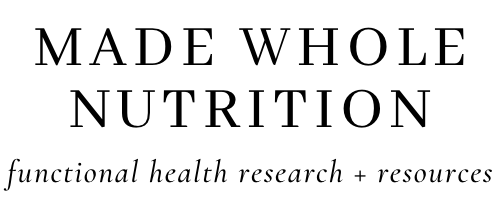A Functional Nutrition Approach to High Histamine
What is histamine?
Histamine is a biochemical produced by immune mast cells as part of the normal inflammatory immune reaction.
It functions as a neurotransmitter and helps regulate digestion.
Histamine only causes issues in the body when someone has too much.
Symptoms of excess histamine include: seasonal allergies, congestion, hives, heartburn, or adverse reactions to high-histamine foods.
Why would someone have too much histamine?
(aka "histamine intolerance" or "mast cell activation syndrome")
There are 2 primary reasons: their body is either producing too much OR not breaking it down properly.
This dysregulation can be influenced by genetics (i.e., poor methylation), hormonal imbalances, or gut dysbiosis (the majority of your immune system is in your gut).
High-Histamine Foods
pickles & sauerkraut
cheese, yogurt, kefir
wine
vinegar
smoked & cured meats
canned fish & seafood
grains*
*Grains are not necessarily high in histamine, but reducing grain consumption can help alleviate symptoms of gut dysbiosis, allergies, and sinus pressure.
What should I do if I have too much histamine?
Many experience relief by avoiding high-histamine foods in their diet and reducing exposure to irritants like dust and pollen.
If the root issue is gut dysbiosis, then addressing that imbalance can help manage symptoms.
Finally, there are many herbs and nutrients that help the body moderate its histamine response.
Nutrients for High Histamine*
probiotics (esp. B. infantis & L. rhamnosus)
raw honey, propolis, bee pollen
vitamin C
quercetin
bromelin
butterbur
stinging nettle
peppermint
ginger
turmeric
*Find these anti-histamine nutrients & herbs as whole foods, supplements, or tea.
Are you a health educator that wants to use this content with your clients? Customize the handout template in less time than it would take to even think about hiring a graphic designer.
References
Ballantyne, S. (2013). The Paleo Approach: Reverse Autoimmune Disease and Heal your Body. Victory Belt Publishing Inc.Ballantyne, S. (2017). Paleo Principles. Victory Belt Publishing, Inc.
U.S. Department of Health and Human Services. Office of Dietary Supplements. NIH Office of Dietary Supplements. Retrieved from https://ods.od.nih.gov/factsheets/list-all/
Jones, D. S., Bland, J. S., & Quinn, S. (2010). Textbook of Functional Medicine. Institute for Functional Medicine.
Gaby, A. R. (2017). Nutritional Medicine (2nd ed.). Fritz Perlberg Publishing.





